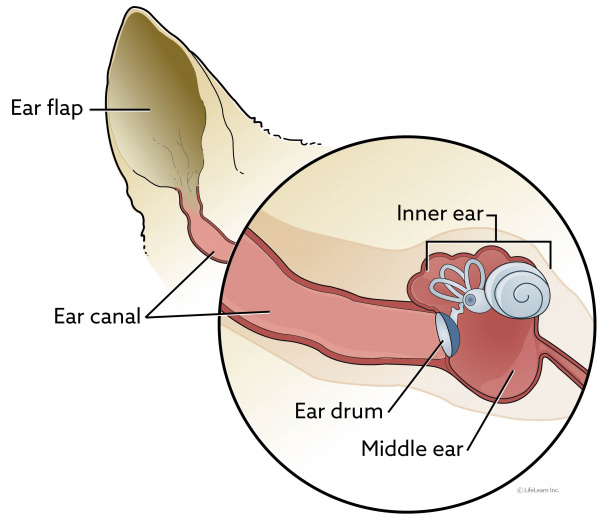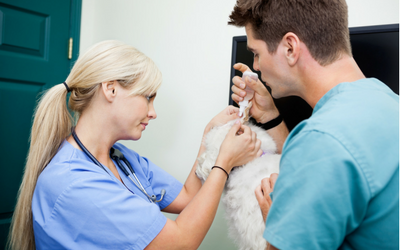How Do You Know if a Dog Has Minor Ear Infection
How mutual are ear infections in dogs?

Infection of the external ear culvert (outer ear infection) is chosen otitis externa and is 1 of the most common types of infections seen in dogs. Some breeds, particularly those with large, floppy or hairy ears similar Cocker Spaniels, Miniature Poodles, or Former English Sheepdogs, appear to be more prone to ear infections, but ear infections may occur in any breed.
What are the symptoms of an ear infection?
Ear infections are painful. Many dogs volition shake their caput and scratch their ears trying to relieve the discomfort. The ears frequently become cherry-red and inflamed and develop an offensive odor. A black or xanthous belch commonly occurs. In chronic cases the ears may announced crusty or thickened and the ear canals often become narrowed (stenotic) due to the chronic inflammation.
Don't these symptoms unremarkably point ear mites?
Ear mites can crusade several of these symptoms, including a black discharge, scratching, and head shaking. Withal, ear mite infections are more common in puppies and kittens. Adult dogs may occasionally contract ear mites from puppies or cats that are infected. Ear mites create an environment within the ear culvert that ofttimes leads to a secondary bacterial or yeast (fungal) infection.
Since these symptoms are like and usually hateful an infection, why tin't I but get some ear medication?
There are several kinds of bacteria and at least one blazon of fungus that unremarkably crusade ear infections. Without knowing the specific kind of infection present, it is not possible to know which medication to utilise. In some cases, the problem is a strange body, a polyp, or a tumor. Treatment with medication lone will not resolve these issues. Information technology is important that your dog be examined to ensure that the eardrum is intact. Administration of certain medications can result in loss of hearing if the eardrum is ruptured. This can only be detected by a thorough ear examination by your veterinarian. 
How do you know which drug to utilize?
First, the ear culvert is examined with an otoscope, an musical instrument that provides magnification and light. This examination allows your veterinarian to make up one's mind whether the eardrum is intact and if there is any foreign material in the canal. When a dog is in farthermost pain and refuses to allow the exam, it may be necessary to sedate or anesthetize the domestic dog for a thorough examination.
The next step is to examine a sample of the material from the ear canal nether a microscope to decide the blazon of organism causing the infection. Microscopic examination is important in helping your veterinarian choose the right medication to treat the inflamed ear canal. Culture and susceptibility tests are often used in severe or chronic ear infections to ensure your pet is receiving the right medication.
How are ear infections treated?
The results of the otoscopic and microscopic examination usually determine the diagnosis and class of treatment. If there is a foreign torso, wax plug, or parasite lodged in the ear canal, it volition be removed. Some dogs must exist sedated for this, or to let a thorough ear flushing and cleaning. Many dogs will have more than one type of infection nowadays (e.grand., a bacterium and a fungus, or ii kinds of leaner). This situation ordinarily requires the use of multiple medications or a broad-spectrum medication.
"Many dogs with chronic or recurrent ear infections accept allergies or depression thyroid function (hypothyroidism)."
An important office of the evaluation of the patient is the identification of underlying affliction. Many dogs with chronic or recurrent ear infections have allergies or low thyroid part (hypothyroidism). If underlying disease is suspected, it must be diagnosed and treated or the pet will continue to experience chronic ear problems.
What is the prognosis?
Nearly all ear infections that are properly diagnosed and treated can be successfully managed. Nonetheless, if an underlying cause remains unidentified and untreated, the consequence volition be less favorable. Several recheck examinations may be needed before the consequence is successful.
How of import is it to treat an ear infection?
Dogs with ear infections are uncomfortable. Their ears are a source of abiding pain and they frequently scratch them and shake their head. This can crusade a condition called an 'audible hematoma,' in which blood vessels in the ear flap break, causing a painful swelling that requires surgical treatment. Deep ear infections can impairment or rupture the eardrum, causing an internal ear infection and fifty-fifty permanent hearing loss.
My domestic dog'southward ear canal is nearly closed. Is that a problem?
Endmost of the ear canal is another result of a chronic ear infection. This is known as hyperplasia or stenosis. If the ear culvert is swollen, it is hard or impossible for medications to penetrate into the horizontal canal. Anti-inflammatory medications tin can sometimes compress the bloated tissues and open the canal in some dogs. Most cases of hyperplasia will eventually require surgery.
What is the goal of ear canal surgery?
There are several surgical procedures that are used to treat this problem. The most commonly performed surgery is called a lateral ear resection. The goal of the surgery is to remove the vertical function of the ear canal and to eliminate the bloated tissue from the horizontal canal. It is relatively easy to remove the vertical canal, just removal of big amounts of tissue from the horizontal culvert is more hard. In some cases, it is necessary to remove the entire ear canal (total ear canal ablation), which may event in permanent harm of hearing. See handout "Total Ear Culvert Ablation and Bulla Osteotomy (TECA-BO)" for information on this surgery.
Is there anything I demand to know about administering medication in the ear?
"It is important to get the medication into the horizontal part of the ear canal."
It is important to get the medication into the horizontal role of the ear canal (encounter above diagram). Unlike our ear canal, the dog'due south external ear canal is L-shaped. The vertical canal connects with the outside of the ear and is the upper part of the 'L'. The horizontal canal lies deeper in the culvert and terminates at the eardrum. The goal is to administer the medication into the lower part of the 'L' - the horizontal ear canal.
The ear culvert may be medicated by following these steps:

- Gently pull the earflap straight upwards and slightly toward the back and hold it with ane hand.
- Using the other manus, apply a small corporeality of medication into the vertical function of the ear canal while continuing to keep the earflap elevated. Hold the ear up long plenty for the medication to run downwardly to the turn between the vertical and horizontal canal.
- Put i finger in forepart of and at the base of the earflap, and put your thumb behind and at the base.
- Massage the ear canal between your finger and thumb. A 'squishing' sound tells you that the medication has gone into the horizontal canal.
- Release the ear and let your canis familiaris shake its head. Many medications will contain a wax solvent and you may observe debris dissolved in this solvent leaving the ear as your dog shakes its head.
If a second medication is to exist used, apply it in the same manner. Typically, you should wait 5-30 minutes before applying additional medications. Exist sure to ask your veterinarian for specific directions regarding any ear medication or cleansing agents.
"Do not use cotton tipped applicators (Q-Tips) to exercise this, as they tend to push debris dorsum into the vertical ear canal."
When all medications have been applied, clean the outer part of the ear canal and the inside of the earflap with a cotton ball soaked in some of the medication. Do not use cotton tipped applicators (Q-Tips) to do this, as they tend to push button droppings back into the vertical ear culvert.
Source: https://vcahospitals.com/know-your-pet/ear-infections-in-dogs-otitis-externa
0 Response to "How Do You Know if a Dog Has Minor Ear Infection"
Yorum Gönder